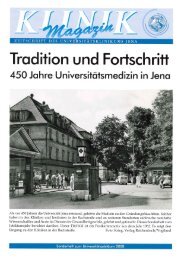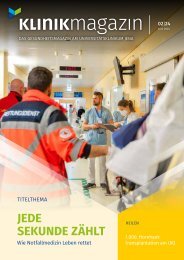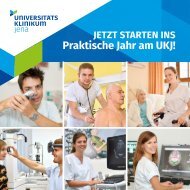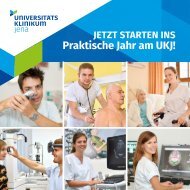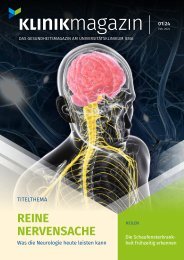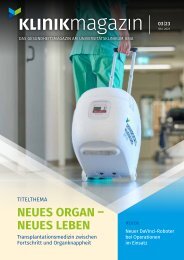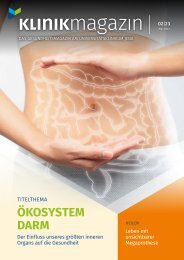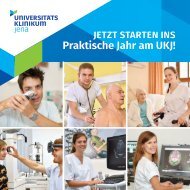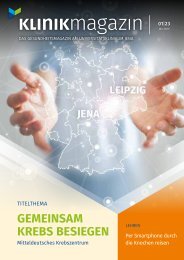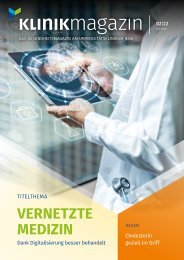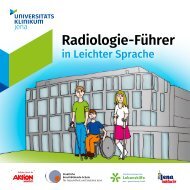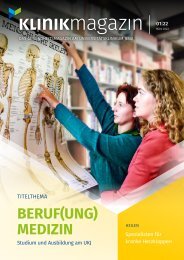Sie wollen auch ein ePaper? Erhöhen Sie die Reichweite Ihrer Titel.
YUMPU macht aus Druck-PDFs automatisch weboptimierte ePaper, die Google liebt.
Institut für Humangenetik<br />
Institute of Human Genetics<br />
Wissenschaftliche Schwerpunkte des Instituts sind die Erforschung<br />
der Mechanismen der Krebsentstehung, der Zellalterung sowie die<br />
Untersuchung chromosomaler Aberrationen und der Interphasekernstruktur.<br />
Mit der Berufung des neuen Institutsdirektors ist die<br />
funktionelle genetische Forschung unter Einsatz von Tiermodellen<br />
am Institut ausgebaut worden. Die Core Units „Transgene Mausmodelle“<br />
und „Chipapplikationen“ der Fakultät des Universitätsklinikums<br />
wurden in das Institut integriert.<br />
Das diagnostische Spektrum des Instituts umfasst Molekulargenetik,<br />
Zytogenetik, Tumorzytogenetik sowie die molekulare Zytogenetik<br />
und wurde <strong>2010</strong> akkreditiert. Es besteht eine enge Zusammenarbeit<br />
mit der Praxis für Humangenetik am Zentrum für<br />
ambulante Medizin.<br />
Forschungsprojekte<br />
Direktor: Prof. Dr. med. Christian Hübner<br />
Adresse: Kollegiengasse 10, 07743 Jena<br />
Christian.Huebner@mti.uni-jena.de<br />
www. humangenetik.uniklinikum-jena.de<br />
A B C<br />
The identification of the molecular mechanisms of carcinogenesis,<br />
cellular senescence, the structure of chromosomes plus interphase<br />
architecture and the characterization of chromosomal aberrations<br />
are important topics of our scientific world. With the appointment<br />
of the new director in <strong>2010</strong> functional analysis of genetic<br />
disorders has been extended. The Core Units for “transgenic mouse<br />
models” and “chip applications“ are now part of the institute.<br />
Since <strong>2010</strong> the diagnostic spectrum of the institute of human genetics<br />
which includes moleculargenetics, cytogenetics, tumorcytogenetics<br />
and molecular cytogenetics has been accredited.<br />
Research projects<br />
A<br />
Abb.2: FAM134B-Knockdown in N2A-Zellen: Rekonstruktion des<br />
cisGolgi Apparats von Wildtyp (A) und Knockdown (B) Zellen.<br />
Fig.2: FAM134B-knockdown in N2A-cells: reconstruction of the<br />
cisGolgi compartment in wild-type (A) and knockdown (B) cells<br />
B<br />
Ionentransporter und GABAerge Transmission<br />
(Prof. Dr. Christian Hübner), DFG 2008-<strong>2010</strong><br />
In diesem Projekt wird die Rolle von Chloridtransportern für synaptische<br />
Inhibition untersucht. Dazu werden verschiedene Mausmutanten<br />
generiert und analysiert (Abb.1).<br />
Ein natürlicher Wirkstoff gegen Prostatakrebs<br />
(Prof. Dr. Aria Baniahmad), Deutsche Krebshilfe <strong>2010</strong>-2013<br />
Wir konnten als erstes einen aktiven Naturstoff isolieren, die Substanz<br />
Atrarsäure (AA) von Pygeum africanum, dessen Rindenextrakt<br />
zur Behandlung von BPH und PCa eingesetzt wird. Im Rahmen<br />
dieses Projektes soll zum einen der molekulare Mechanismus<br />
der Hemmung des ARs und zum anderen die anti-Tumorwirkung<br />
von androgen-abhängigen und -unabhängigen PCa durch AA in<br />
vivo analysiert werden.<br />
Biochip für die Diagnose kolorektaler Tumore<br />
(Prof. Dr. Ferdinand von Eggeling), BMBF 2007-<strong>2010</strong><br />
Im Rahmen eines BMBF-geförderten Projektes untersucht die Core<br />
Unit Chip Applications CUCA in Zusammenarbeit mit der Universität<br />
Lübeck und dem DKFZ potentiell diagnostisch nutzbare Marker<br />
für das Kolonkarzinom. Ziel ist die Entwicklung eines Screeningverfahrens,<br />
welches möglichst früh die Entwicklung eines Tumors<br />
im Serum anhand einer Proteinsignatur erkennt, und somit gezielte<br />
therapeutische Maßnahmen ermöglicht.<br />
Nachweis von kryptischen Veränderungen in bänderungs-zytogenetisch<br />
unauffälligen Fällen mit ALL<br />
(PD Dr. Thomas Liehr), Monika-Kutzner-Stiftung <strong>2009</strong>-2011<br />
In diesem Projekt werden neue kryptische Aberrationen mittels<br />
selbst entwickelter „high resolution multicolor fluorescence in<br />
situ hybridization (FISH)“ Verfahren nachgewiesen, und die Häufigkeit<br />
dieser neu identifizierten Aberrationen in ALL Patienten mit<br />
und ohne bänderungszytogenetisch nachweisbare Veränderungen<br />
etabliert. Hierdurch soll insgesamt ein wesentlicher Beitrag zur<br />
Klassifikation der ALL in therapeutisch relevante Risikogruppen<br />
geleistet werden.<br />
Abb.1: KCC2-Expression im Kleinhirn: A, Wildtyp; B, Purkinjezellspezifischer<br />
Knockout; C, Körnerzell-spezifischer Knockout.<br />
Fig.1: KCC2 expression in the cerebellum: A, wild-type; B, Purkinje-cell-specific<br />
knockout; C, granular-cell-specific knockout.<br />
Funktionelle Analyse der FAM134-Genfamilie und Pathophysiologie<br />
der FAM134B-assoziierten sensorischen<br />
und autonomen Neuropathie Typ 2<br />
(Dr. Ingo Kurth/Prof. Dr. Christian Hübner), DFG <strong>2010</strong>-2013<br />
Ziel dieses Projekts ist die Untersuchung der Funktion des FAM134B<br />
Proteins und seiner Homologe, um so die Pathophysiologie der<br />
FAM134B assoziierten sensorischen und autonomen Polyneuropathie<br />
HSAN2 aufzuklären (Abb.2).<br />
Weitere Projekte<br />
Schilddrüsenhormon-regulierte Differenzierung von<br />
Neuroblastoma (Prof. Dr. Aria Baniahmad)<br />
Funktionelle Untersuchung der neuronalen Anionenaustauscher<br />
mit transgenen Mausmodellen<br />
(Prof. Dr. Christian Hübner)<br />
Bernstein Fokus Jena, TP 4: Erzeugung von Mausmodellen<br />
zur in vivo-Modulation der kortikalen Netzwerkaktivität:<br />
Aktivierung und Hemmung durch Licht<br />
(Prof. Dr. Christian Hübner)<br />
Transgene Mausmodelle für die hereditäre spastische<br />
Paraplegie Typ 31 und axonale Degeneration<br />
(Prof. Dr. Thomas Deufel, Prof. Dr. Christian Hübner)<br />
Charakterisierung genomischer Imbalancen bei kindlichen<br />
Nebennierentumoren<br />
(Dr. Anita Glaser, Prof. Dr. Ferdinand von Eggeling)<br />
Besondere Leistungen<br />
Das Institut war im September <strong>2010</strong> Gastgeber der Jahrestagung<br />
der Deutschen Gesellschaft für Genetik „Evolution of Primates“.<br />
Mitarbeiter des Institutes organisierten das 2. PWG Treffen auf der<br />
7th European Cytogenetics Conference <strong>2009</strong> in Stockholm.<br />
<strong>2009</strong> erschien das von PD Dr. Thomas Liehr herausgegebene Fachbuch<br />
„Fluorescence in situ Hybridization (FISH) Application guide“,<br />
ISBN-10: 3540705805; ISBN-13: 978-3540705802.<br />
Ion transporters and GABAergic Transmission<br />
Aim of the project is the elucidation of the role of chloride transporters<br />
for neuronal homeostasis and synaptic inhibition (Fig.1).<br />
Inhibition of prostate cancer by a natural compound<br />
We have isolated the first natural compound, atraric acid that<br />
inhibits the AR-mediated transactivation and prostate cancer<br />
growth. Within this project the detailed molecular mechanism of<br />
inhibition by atraric acid and its effect on androgen-dependent<br />
and androgen-independent prostate cancer will be analyzed.<br />
Diagnostic serum protein chip validation for population<br />
wide colorectal cancer screening<br />
Financed by the BMBF the CUCA investigates in cooperation with<br />
the university of Lübeck and the DKFZ the diagnostic potential of<br />
several tumor markers in colorectal carcinoma. The development<br />
of a screening tool is proposed that can detect as early as possible<br />
the development of a tumor by a serum based protein signature.<br />
Detection of cryptic chromosomal rearrangements in<br />
Acute lymphoblastic leukemia (ALL)<br />
In this project new cryptic aberrations are identified by self-developed<br />
high resolution multicolor fluorescence in situ hybridization<br />
(FISH) approaches; also the frequency of these aberrations in ALL<br />
patients with and without cytogenetically detectable rearrangements.<br />
This study will provide essential data for cytogenetic classification<br />
of ALL into therapeutic relevant risk groups.<br />
Functional Analysis of the FAM134 gene family and<br />
pathophysiology of the FAM134B related sensory and<br />
autonomic neuropathy type 2<br />
In this project we try to understand why loss of FAM134B results in<br />
a severe neurodegenerative disorder. Furthermore we will address<br />
the role of the other members of the FAM134 gene family (Fig.2).<br />
Outstanding achievements<br />
The institute hosted the Conference of the German Genetics Society<br />
„Evolution of Primates“ in September <strong>2010</strong>. Institute members<br />
organized the 2. PWG Meeting at the 7th European Cytogenetics<br />
Conference in Stockholm in <strong>2009</strong>. PD Dr. Thomas Liehr edited „Fluorescence<br />
in situ Hybridization (FISH) Application guide“, ISBN-10:<br />
3540705805; ISBN-13: 978-3540705802 in <strong>2009</strong>.<br />
Further projects<br />
Thyroid hormone regulated differentiation of neuroblastoma<br />
cells<br />
Functional analysis of neuronal anion-exchangers with<br />
transgenic mouse models<br />
Bernstein Focus Jena, Subproject 4:<br />
Generation of mouse models to modulate cortical network<br />
activity in vivo: excitation and inhibition by light<br />
Transgenic mouse models for hereditary spastic paraplegia<br />
SPG 31 and axonal degeneration<br />
Characterization of genomic imbalances in infantile tumors<br />
of the adrenal gland<br />
Publications<br />
• Papaioannou M, et al. The natural compound atraric acid is an<br />
antagonist of the human androgen receptor inhibiting cellular<br />
invasiveness and prostate cancer cell growth. J Cell Mol Med.<br />
<strong>2009</strong> Aug;13(8B): 2210-23.<br />
• Kurth I., et al. Mutations in FAM134B, encoding a novel Golgi<br />
protein, cause severe sensory and autonomic neuropathy.<br />
Nature Genetics, <strong>2009</strong>, 41(11): 1179-81<br />
• F. Leviel*, C.A. Hübner*, et al. Identification of a novel amilorideresistant,<br />
thiazide-sensitive NaCl reabsorption pathway in the<br />
distal nephron. Journal of Clinical Investigation, <strong>2010</strong>, 120(5):<br />
1627-35.<br />
• Melle C, et al. Proteomic analysis of human papillomavirusrelated<br />
oral squamous cell carcinoma: identification of<br />
thioredoxin and epidermal-fatty acid binding protein as<br />
upregulated protein markers in microdissected tumor tissue.<br />
Proteomics. <strong>2009</strong> Apr;9(8): 2193-201.<br />
• Mkrtchyan, M, et al. Early embryonic chromosome instability<br />
results in stable mosaic pattern in human tissues. PLoS ONE<br />
<strong>2010</strong>, 5: e9591.<br />
48|49



